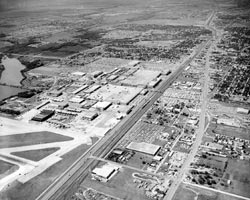|
|
|
In 1946 the government, in an effort to implement the recommendations of the study groups, attempted to interest prime aircraft contractors located in congested pre-war plants to relocate to the more modern facilities constructed during the war. The Chance Vought Aircraft plant at Stratford was one of the first plants the government, through the Navy, contacted. The Stratford plant had been expanded to meet increased wartime production by using construction shortcuts and wartime substitutes. Rather than an orderly facility, it rambled without organization. Because flight test facilities were not large enough for new jet aircraft, all the XF6U-1 flight tests were done at the nearby Bridgeport Municipal Airport. Safety and security requirements resulted in the flights being continued at Muroc Dry Lake in California, adding cost and inconvenience to the project. On the other hand, the Navy was offering Vought a new plant with almost twice the space as Stratford. The buildings had been laid out in an orderly fashion for large production contracts which would make for a more efficient and economical manufacturing operation. Excellent airport facilities were adjacent to the plant and the weather was favorable to increased flight operations. Rex Beisel, as Vought’s General Manager, argued the case to move before United’s executives. He got more than a little help from the Dallas Chamber of Commerce. By moving to Texas, Beisel also saw a chance to get out from under the corporate overhead and enjoy some autonomy. In April 1948, the Navy announced that Chance Vought would move its entire operation to the Naval Weapons Industrial Reserve Plant in Dallas, Texas. The move was completed on June 30, 1949. – the largest industrial move of its kind up to that time. Metro Goldwyn-Mayer announced a film would be made of the historic move. The movie, to be entitled “Yankee in Texas” with Spencer Tracy never came off as political pressure led by Connecticut’s governor, Chester Bowles sought to stop the unfavorable publicity he felt this exposure would give their state. Twenty-seven million pounds of equipment and 1,300 key personnel and their families were moved the 1,700 miles during 1948-1949. |

 At the end of World War II, there were several government studies made regarding the demobilization of the aircraft industry and the preservation of a sufficient production capability for future national defense. All the studies recommended that dispersal, which had been somewhat achieved during the course of the war, be considered in the selection of a post-war industrial base.
At the end of World War II, there were several government studies made regarding the demobilization of the aircraft industry and the preservation of a sufficient production capability for future national defense. All the studies recommended that dispersal, which had been somewhat achieved during the course of the war, be considered in the selection of a post-war industrial base.